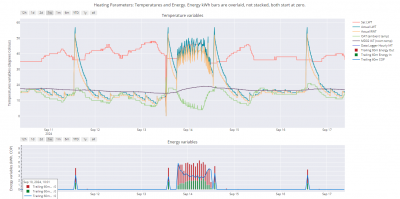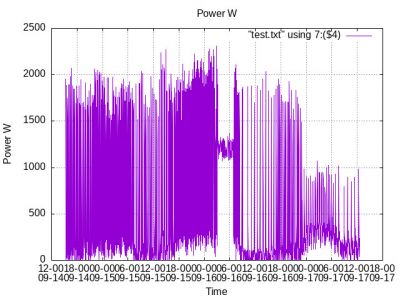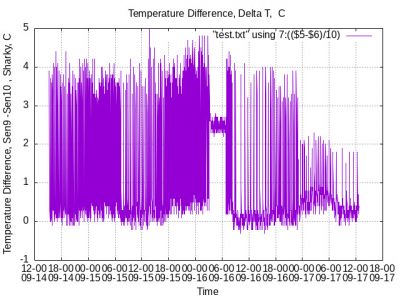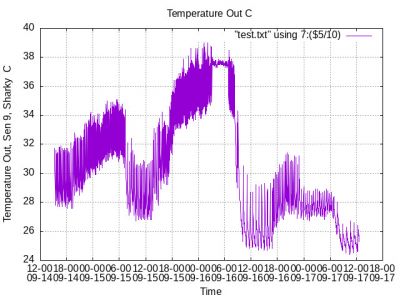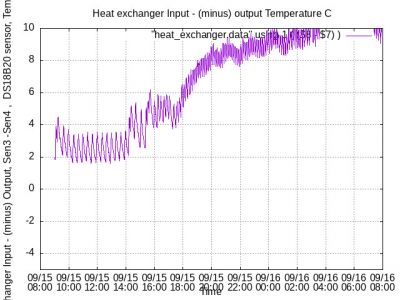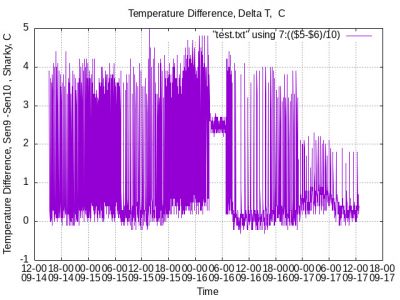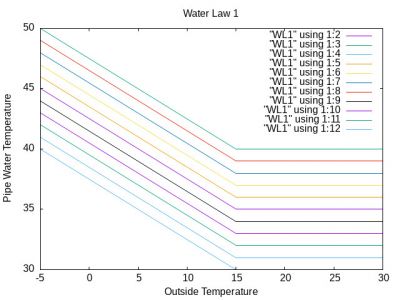Posted by: @derek-mAs I stated, fitting a switch is a test. If you are going to question every piece of advice that I give then I'm afraid that you are just wasting my time.
@derek-m - You mean like he has been doing for the last 76 pages, and mine, and that of several other very kind folk?
Posted by: @cathoderayAs I am sure you (and @jamespa) appreciate, you don't need to physically short the room stat (what could possibly go wrong?), all you need to do is set it low enough, and then it will effectively short itself (be always on).
@cathoderay - I tried that approach about 10 pages back (actually the thermostat needs to be set high not low, so that it is always demanding heat, or very low if you want the heat pump off). First of all Ian said it wasn't possible, then when I pointed out how to do it (there was an installer setting that needed to be overridden) Ian refused.
@iantelescope - much as I sympathised with your initial predicament, you tease people freely giving their time, by apparently listening for a short period Then when advice is given you mostly don't follow it and go off at a tangent. You also appear to ignore important questions and requests. Step and repeat...
As a direct consequence, 77 pages later, you are no further forward. I no longer sympathise. Good luck.
4kW peak of solar PV since 2011; EV and a 1930s house which has been partially renovated to improve its efficiency. 7kW Vaillant heat pump.
I am thinking to eliminate another variable you should maybe ask Ian to set both the pumps to fixed speed. It is just another variable you could do without and if it is adjusting sporadically it maybe influencing the heat pump performance. Not sure if you would see that from heat meter as not sure we trust that data.
Thanks. Doing this would, as you say, eliminate another variable and I did consider suggesting it (and, if this were my system, it is what I would do at this stage)
However as you can see if you read back a few pages (and particularly if you read back 77 pages) the percentage of requests that are actually implemented at all is small, and even those that are implemented take a lot of persuasion and require enduring a load of tangential drivel in the interim. So I set it aside.
I have now lost patience anyway but thank you for your suggestion.
4kW peak of solar PV since 2011; EV and a 1930s house which has been partially renovated to improve its efficiency. 7kW Vaillant heat pump.
Posted by: @johnmacleod10I am thinking to eliminate another variable you should maybe ask Ian to set both the pumps to fixed speed. It is just another variable you could do without and if it is adjusting sporadically it maybe influencing the heat pump performance. Not sure if you would see that from heat meter as not sure we trust that data.
If my understanding is correct both pumps are operating at a fixed speed if Ian is to be believed.
According to his post a few pages back the speeds of both pumps are controlled by an Arduino based system. I did ask what behaviour it targets but got no reply.
I am also 'out', but am responding to you as a courtesy.
4kW peak of solar PV since 2011; EV and a 1930s house which has been partially renovated to improve its efficiency. 7kW Vaillant heat pump.
Posted by: @iantelescopeI regularly change the parameters experimentally :
1) 201* Low 15C Outdoor Air Temperature
2) 201* High -5C Outdoor Air Temperature
3) 202* Low 30 C or 33 or 35 C Water Law 1
4) 202* High 40 C or 45 C or 50 C Water Law 1
I found the above in one of Mr T's previous posts, from August this year, not the ideal time of year to set up weather compensation. Samsung don't make it easy to understand, but I think I am right in saying the above translates into
30 or 33 or 35 degree C LWT @ 15 degree C OAT for right hand end point (warmer OAT)
40 or 45 or 50 degree C LWT @ -5 degree C OAT for left hand end point (colder OAT)
"I regularly change the parameters experimentally" sounds ominous, it is better to run the system for a while, certainly more than a day, to see what effect the current settings have, by monitoring the IAT. This is the data that seems to be missing, yet, as noted above, it is (as a proxy for human comfort, the ultimate measure) the culmination of everything that goes into a heat pump.
I rather suspect that if Mr T was Dr T in front of a patient with a fever, he would ignore the patient's temperature, and focus instead on charts showing the patient's toe nail selenium levels. Finding toe nail selenium levels interesting is no excuse, you cannot ignore the basics.
Midea 14kW (for now...) ASHP heating both building and DHW
Did you install the switch as suggested?
How long before IAT and OAT measurements will be available?
As an alternative to monitoring toe nail selenium levels, here is an example of the monitoring I have for my heat pump, done over modbus (which many heat pumps including Midea and Samsung have, though the latter needs an adaptor board) using python:
The chart covers the last week, using minute data, ie readings are taken once a minute for the temperature variables, and hourly totals for the energy variables. It tells me pretty much everything I need to know. The green line is the outside air temp (from the Midea sensor in the heat pump), and on the left hand side of the chart we can see the daytime and especially the overnight temperatures dropping lower and lower, and, as a result, the indoor air temp (purple line) also starts to fall, until it gets to 14.6, when I said enough is enough, and turned the heating on, by setting the room stat to 26 degrees. In the upper chart we can see the LWT and RWT rise to cycle around the set LWT, and the house starts to warm up, slowly, because that's the way ASHPs work. In the lower chart we can see the hourly energy used and produced, and the hourly COP. My heat pump almost always cycles, but it is low frequency, once or twice and hour, and not a particular concern. We can also see, more as a matter of interest rather than anything else, the dips in the OAT when the heat pump is running, caused by the cooler exhaust air. For now, I am content to use the Midea OAT sensor, because it records the actual OAT that the heat pump experiences. At some point I may add a separate third party OAT sensor, but I am still faffing about on where to put it. Once the OAT (and IAT) improved a bit, I turned off the heating, by setting the room stat to 10 degrees. The isolated big spikes are the DHW heating, which is timed to come on for an hour in the middle of the day, subject to the DHW tank temperature (it is recorded, but not plotted on this chart) being below 40 degrees.
The baseline weather compensation curve end points are 56 @ -4 and 34 @ 15, -4 on the left hand end so the heat pump continues to vary its output at lower OATs. It took perhaps a couple of months to establish that these were the right values for my house in my location, and they can be varied if circumstances change, eg if I add a lot more heat loss reduction measures (not that I have many options), I might be able to lower the LWT a degree or two. These baseline end points are then subject to an auto-adapt regime, which uses a python script to check the difference between the desired IAT (19 degrees) and the actual IAT every hour, and adapt the weather compensation curve end points accordingly: for every degree the IAT is below what it should be, raise the Set LWT by one degree (by shifting the weather compensation curve upwards), up to a maximum increase of three degrees, for every degree the actual IAT is above what it should be (maybe due to solar gain), lower the set LWT by one degree. Any changes get logged to a csv file, so I can confirm the auto-adaption is working as it should do.
This is the sort of data we need from Mr T if we are to be able to provide further assistance. It doesn't need to be in exactly the same format that I use, but it does need to be a consistent and readable time series of the variables that matter. Everything else is superfluous, or worse, a futile distraction.
Midea 14kW (for now...) ASHP heating both building and DHW
Many thanks @cathoderay for your understanding.
Overheating and Short cycling.
My Heat Pump, without a Thermostat has been the subject of an experiment to see if a Heat Pump can be ONLY controlled by Weather Compensation , Aka, Samsung Water Law .
On the first night of this experiment the Room Temperature increased to an uncomfortable 25 C after midnight on the 15th.
The Heat Pump Cycle time reduced , to eventually Zero , Which I interpreted as the Heat Pump completely Stopping cycling.
For this experiment the Water Law lower defining coordinate was increased from 15 C to 20 C.
I reduced the Water Law lower defining coordinate to 17 C for the experiment, last night , the 16th Sept..
The Room Temperature again increased to an uncomfortable 25 C just before midnight.
Buffer .
I then opened the valve allowing the Buffer to increase the Pipe Water volume by 50 litres.
Consequence:
With the increased Water Volume the Cycle Time increased :
Power,Delta T 9 Sen9 -sen10, and output Temperature from the Sharky Sen9
Taken by a Sharky Water Power Meter.
With the Cycle Amplitude greatly reducing at Midnight on the 16th Sept the buffer has significantly increased the Cycle Time avoiding the Complete failure of the Cycling system as seen on the previous night.
Conclusions:
1) Without a Thermostat , the Heat Pump Cycle time is completely controlled by the difference between the Supply and consumption of energy.
2) The Cycle Time can consequently be reduced to Zero with no thermostat to provide a fixed Cycle Time.
3) The Room Temperature , can rise to 25 C without the intervention of a Thermostat.
4) A Thermostat with a fixed Cycle Time is required.
Sensors?
As a matter of interest here is the differential , Delta T obtained by a
1) pair of Thermo couples, Sen7 - Sen8
2) A pair of DS18B20 Sensors., Sen3-Sen4
Note here the large, 10 C Delta_T , on the inputs to the Heat Exchanger compared to the output ports:
3) Output Radiator DeltaT as measured at Sen9 -Sen10
Note that the Radiator flow rate has been reduced from ~17 Liters per minute to ~7 liters per minute in an attempt to increase the output Radiator Delta_ T.
Conclusions about measurements:
1) The Sharky is much more accurate than the Thermocouples OR the DS18B20 .
2) The Sharky is much more tolerant of noise than either the DS18B20 Or the Thermocouples.
Please don't shoot the pianist ....he's doing his best.
I appreciate the Samsung jargon doesn't help, on one level it is upside down and/or inside out. I find it easier to think in the xx @ yy format, LWT at xx degrees when OAT is yy degrees. Foe example, for the left hand end (lower OAT), I have 56 @ -4, LWT at 56 degrees when the OAT is -4.
What your remarks above suggest, assuming the system was only under weather compensation control, is that the weather compensation curve was still too high (the line on the chart is too high) on both occasions. What I am not sure about (because of the Samsung jargon) about is what you first increased (from 15 to 20) and then lowered (to 17). These numbers suggest to me the X axis on the weather compensation curve, the OAT, where as what you actually want to adjust (to a lower value) is the Y value (the LWT). You want a lower LWT for a given OAT, to prevent the IAT overshooting to 25 degrees.
Midea 14kW (for now...) ASHP heating both building and DHW
Many thanks for your help.
Thermostat re-connected.
With my Thermostat re-connected the Heat Pump is slowly returning to a stable operating condition.
Cycling time , Short Cycling?
With the Honeywell Home Thermostat Re-connected:
1) The cycle timing is , slowly returning to that set by the Thermostat , 20 minutes.
2) The Water and Room Temperatures are slowly returning to that set by the Thermostat.
Conclusions:
1) My Heat Pump will work , for long periods during the daytime , providing a stable Room and Water Temperature , without a Physical Room Thermostat.
2) My Heat Pump , when run without a Thermostat will , however, reduce the Cycle Time to zero as the difference between the Water Temperature and the Weather compensation curve reduces to Zero.
3) Reducing the Cycle time to zero when the Water Temperature approaches the Weather Compensation curve is potentially very damaging the Heat Pump
4) My Heat pump will , when approaching a Zero Cycling time , increase the room Temperature to an unacceptable 25 C.
It is all in a name:
Samsung Water Law = Weather compensation curve on other Heat Pump manufacturers.
The Water Law , aka Weather compensation system, behaves as a separate Themostat with the
Cycle time being the time that the volume of water within the pipes takes to reach the Temperature set by the Water law curves:
Please forgive any failure on my part , in my understanding of the Weather compensation curves .
I am , possibly wrong !
Final conclusions:
1) A physical Thermostat is Required to stop Zero length Cycle Times.
2) A physical Thermostat is Required to stop Room temperature surges .
- 26 Forums
- 2,342 Topics
- 53 K Posts
- 413 Online
- 6,000 Members
Join Us!
Worth Watching
Latest Posts
-
Controlling Daikin Altherma via P1P2 and Home Assistant
Are there any fellow Daikin Altherma 3M owners who are ...
By weoleyric , 15 minutes ago
-
RE: Configuring third party dongle for Ecodan local control
However, I've found the documentation doesn't work exac...
By F1p , 1 hour ago
-

RE: Setback savings - fact or fiction?
@robs — thanks again for your detailed comments. Some r...
By cathodeRay , 2 hours ago
-
RE: Are We Sleepwalking Into Another Race to the Bottom?
The thing that worries me is that this brainless crap i...
By JamesPa , 3 hours ago
-
RE: Free Ecoheat Heat Pump Install
I don't mind thread drift, it's how conversation natura...
By Deltona , 4 hours ago
-

RE: A Smarter Smart Controller from Homely?
@papahuhu I hope you get a swift resolution. Regards, T...
By Toodles , 6 hours ago
-

RE: Poll for Time of Use, tariffs, technology
That’s fine by me too Major, I feel it is a sad reflect...
By Toodles , 7 hours ago
-

Bingo. Sometimes a judiciously placed size 10 bovver bo...
By Majordennisbloodnok , 7 hours ago
-
RE: Mitsubishi Ecodan 11.2kW heat pump with low COP
@ciocoiu-alexandru I can't provide the same level of di...
By Sheriff Fatman , 8 hours ago
-
RE: Octopus Cosy Heat Pump Owners & Discussion Thread
Recently had my follow up with octopus for the vibratio...
By swwils , 9 hours ago
-

The three technical issues I'm considering are: BMS...
By Transparent , 10 hours ago
-
RE: LiFePO4 lithium battery fires and explosions
@transparent Your post may fit better in th...
By Batpred , 10 hours ago
-

RE: British Gas vs Octopus Energy vs Heat Geek vs EDF vs Aira vs OVO vs EON.Next vs Boxt
@jamespawhite, if you could be bothered, you could also...
By Mars , 12 hours ago
-
RE: Commencing on an ASHP Installation Process
I've got a bit of time to draft something today, so the...
By Sheriff Fatman , 1 day ago
-
RE: Help with heat pump sizing
@amin I dont think materially relative to t...
By JamesPa , 1 day ago
-

@majordennisbloodnok I have decided to take the plunge....
By TechnoGeek , 1 day ago
-
RE: Different dT on each radiator?
I cant sorry. Its based on some calculations I did fro...
By JamesPa , 2 days ago
-
RE: Help me keep the faith with my air source heat pump installation
@simonf thats interesting as I’ve noticed my flow and r...
By AdamK , 2 days ago


